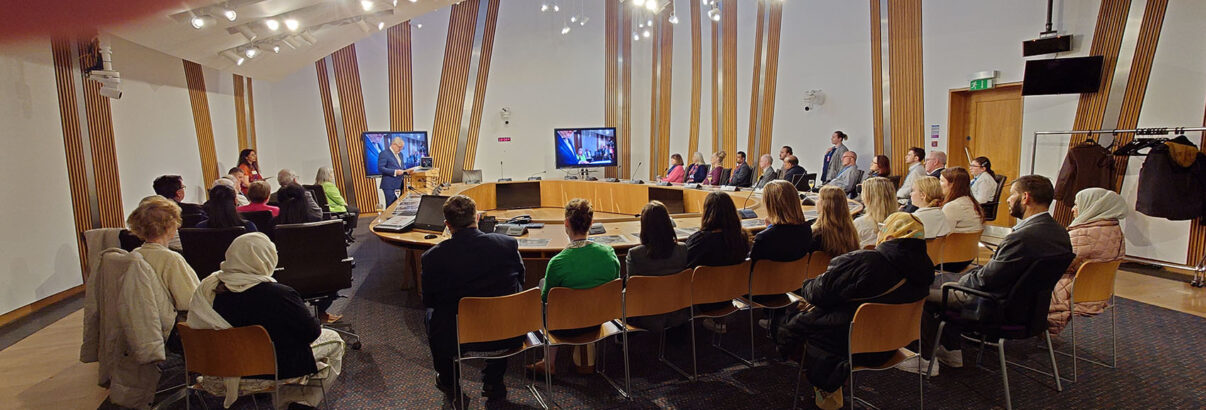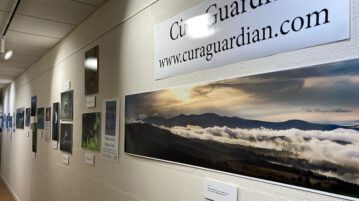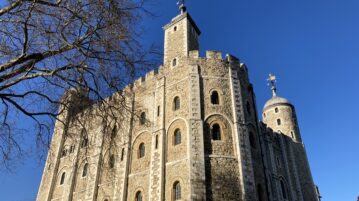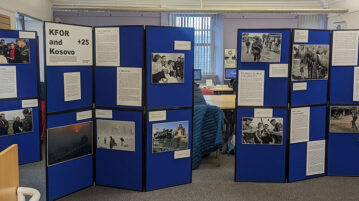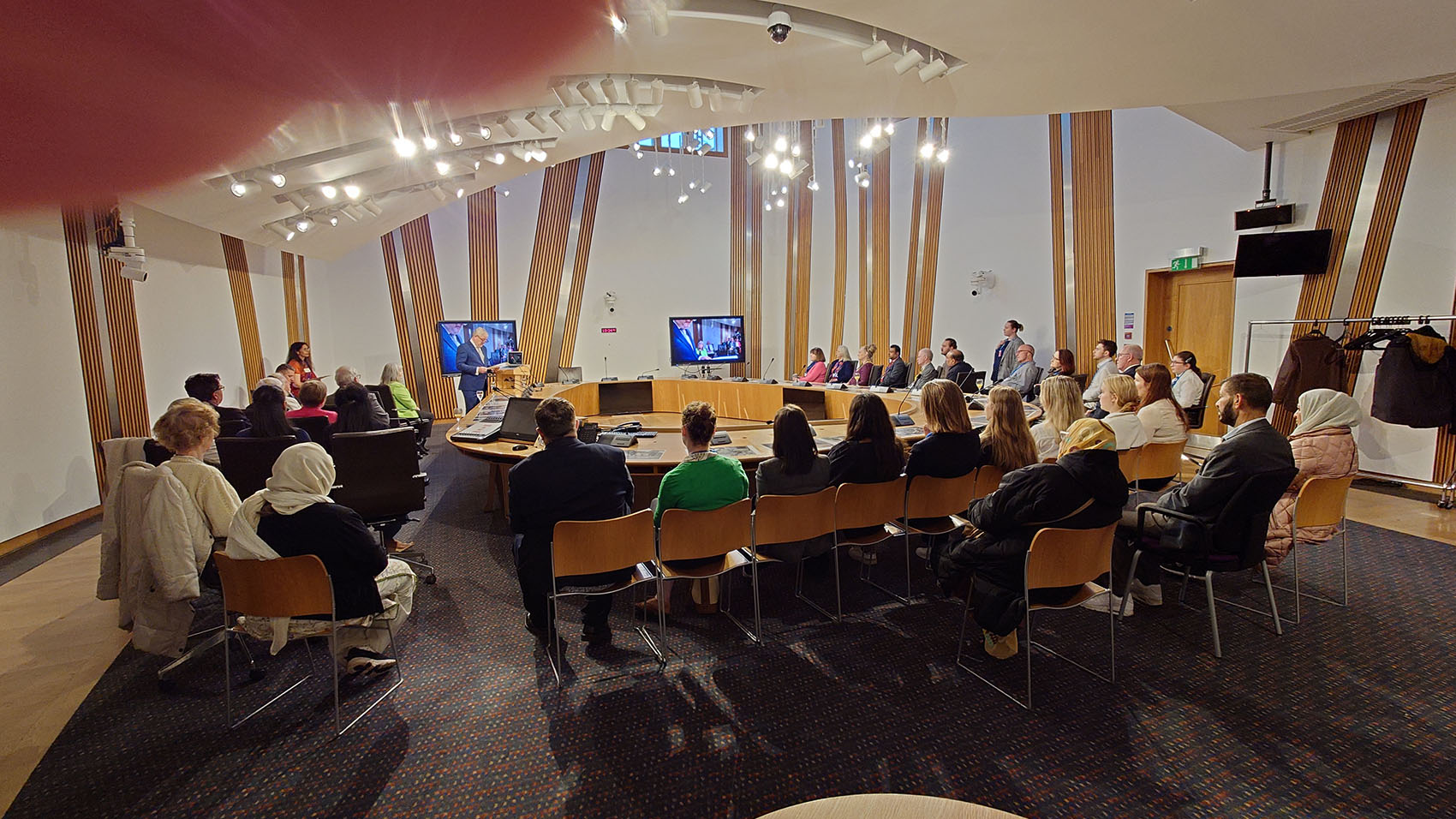

On September 19th, 2023, an event to mark the 25th Anniversary of the 2nd UN Resolution which led to the intervention of KFOR in Kosovo one year later, took shape in the Burns Room of The Scottish Parliament. The event was opened by sponsoring MSP, Ms Rhoda Grant and Scottish Government Cabinet Secretary for Constitution, External Affairs and Culture, Mr Angus Robertson.
This story goes back to 1999, when KFOR, the NATO led international peacekeeping force, entered Kosovo following resolution 1244 by the United Nations Security Council. 2024 will mark the 25th anniversary of that deployment. The first UN Security Council Resolution connected to Kosovo was passed on 31st March 1998 and the second on the 23rd September 1998. This was followed by a series of resolutions culminating in Resolution 1244 one year later.
Heartstone’s documentary photographer Nick Sidle, was attached to KFOR in the operation’s early stages. He was embedded with several units over the course of one year and produced a unique record of the work of the peacekeepers showing troops from nine different countries including nineteen individual regiments or units from the United Kingdom and the United States, the two largest contributors to KFOR.
The photostory captured not just the work of the soldiers, it did more. World events are happening all the time but it is not long before the world moves on. Histories are written and often fought over and about the largest themes and significances but all too often the stories of those who worked the hardest, achieved the most and deserve so much credit are overlooked and forgotten. To bring those stories to life and earn the attention they deserve demands storytelling of the highest order. In the 20th century and now into the 21st, that storytelling became visual and whilst there has been an increasing and global coverage, only a few practitioners have achieved more than just the record and extended their documentary practice to become an art form that serves to go beyond the communication of events into the sharing of feelings, experiences and lives. This is what ‘KFOR and Kosovo+25’ is about, when the exhibition was first presented in 2001 and now, 25 years later in a new form restored, extended and updated for the present day. It presents the human story, to enable audiences beyond the country to empathise and understand a world in which intolerance and hate had been taken to new levels and why there was a need for the peacekeeping intervention to safeguard lives and homes, and help rebuild ordinary life in what were extraordinary circumstances.
The question is what is its relevance today?
25 years later, this story is not over. It is a documentary of a period of history that must not be forgotten, but it also holds many lessons for our time in a world where many continue to live with conflict, circumstances which are impacting on all of us, including within Scotland. We must remember KFOR is still active in Kosovo. The photostory, and the discussion it leads to, takes its audiences, through a visual, non-political, cultural medium, into a world where they can empathise with those of different backgrounds, understand the commonality of human experience, feel what living with prejudice/hate/intolerance at the day-to-day level means, why this needs to be addressed and particularly in times of difficulty, the need for peacekeeping forces, understand more clearly the refugee experience, see practical examples of resilience and hope and the importance of people working co-operatively together to achieve a positive goal.
The exhibition also provides a setting for numerous personal experiences and stories to be told, which may not have been heard before, including those of veterans, and thus a new mechanism to educate the next generation in a way which is appealing, engaging and inspiring. It is helping to bring people together, particularly those who would otherwise not meet, to generate meaningful contact, discussion and dialogue from which understanding and empathy can follow.
Heartstone is working with the support of Lord George Robertson, Gen Sir Nick Carter, UNA Scotland, Interfaith Scotland, Poppyscotland, Officers Association and Legion Scotland on this new project to mark this important anniversary, which will see the restoration and exploration of the original images with the addition of new narrative. This includes the stories of some of the veterans and civilians, including some who were children at the time, who are featured in the images and who have been tracked down to add their stories in time for the 25th anniversary in June 2024.

Restored Images and finding the people in the pictures
At this event, some of the first images which have been restored were presented to an invited audience of people across all faiths, nationalities, backgrounds, races, faiths and cultures. At the time of the photodocumentary, the digital era had not yet begun and the entire story is captured on film. This is therefore the start of what will be a long process of selection and restoration before assembly of the final exhibition.
The event provided a practical demonstration of how the images can become the mechanism through which people can come together, and the value of photodocumentary which uses an artistic/cultural non-political approach to generate meaningful discussion and dialogue.
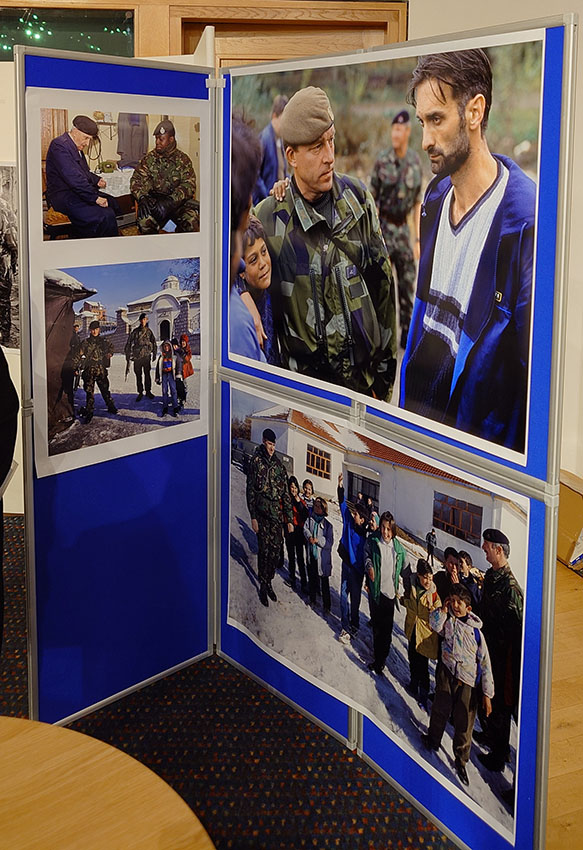
By the time of the event, Ms Eliza Hoxha, MP in the Kosovo Parliament, who joined online from Kosovo, confirmed she has successfully been able to work with local colleagues and identified at least one of the children in the Burice School image (on right, bottom image), who in turn has identified two more. Now in their 30’s, these people will be adding in their stories, 25 years later providing a real sense of the impact of what was done. In addition, Lt Col (retd) John Smith, also in the image, has been identified, from 1st Queen’s Dragoon Guards, and will be contributing his story into the exhibition.
The reaction to the images even at this earliest stage has been outstanding. Despite being 25 years old and all on film, the restored images are of superb quality and capture the reality of what happened.

Ms Rhoda Grant, MSP
As sponsoring MSP, Ms Rhoda Grant welcomed everyone, those assembled in the room and also those joining online from other parts of the UK and Kosovo.
She said:
‘It is my pleasure to sponsor this event and to welcome you all to the Scottish Parliament. We have, with us tonight, people who have fought for our freedoms, people who have endured war and conflict, people that have fled their homes in fear. Things that the more fortunate of us cannot possibly begin to imagine.
This exhibition reminds us of what happened in Kosovo 25 years ago. Nick’s photographs also reminds us of the actions that were taken to intervene.
Peace is precarious – something evidenced by the ongoing conflict in Ukraine and the tensions that still fester in Kosovo. We must remember why NATO and the UN declaration on human rights were created and why they still necessary today, to protect the rights and freedoms of all.
The photographers and press reporters who travel to regions affected by conflict serve an incredibly important role. They not only record history, but they are the vehicle for voices to be heard. They report the reality. Nick Sidle’s career and work is truly awe inspiring. From the Highlands to Kabul and Kosovo and Bosnia.
I want to thank him for being here this evening through his work and sharing it with us, to remind us of our role in protecting the freedoms and democracies.
I also want to thank all our distinguished speakers for what they have done, and continue to do, and for being here to share their experiences with us this evening.’
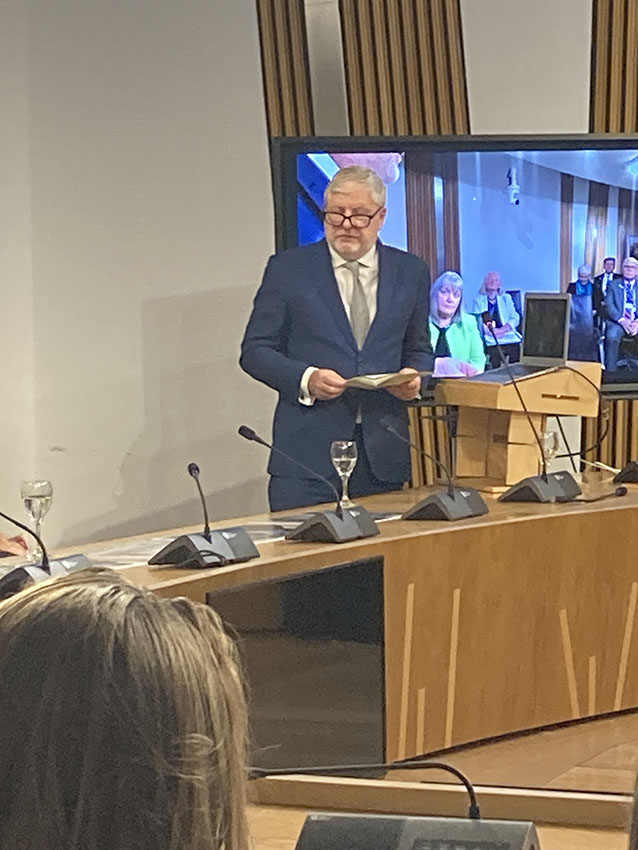
Scottish Government Cabinet Secretary for Constitution, External Affairs and Culture, Mr Angus Robertson
Mr Angus Robertson’s presence was particularly important to emphasise the importance of the human story in any conflict situation, past or present and the role a photodocumentary can play in helping us all to empathise, understand and connect with people.
This project has the potential to be a significant international cultural event for 2024, and progress towards that goal started from this event.
Rt Hon Lord Robertson of Port Ellen KT GCMG HonFRSE PC
This project has been brought to life with the help of a few key supporters, one of whom is Lord George Robertson. NATO Secretary-General at the time when the photodocumentary was produced, Lord Robertson assisted at the time to help secure the access needed and ensure images from the story were presented at NATO HQ in Brussels alongside an exhibition at the Brussels European Parliament. With his help once again, the partners in Kosovo have been brought to this initiative and initial sponsorship for the development has been secured from Lord Michael Hintze. Lord Robertson said:
‘This is not just an ordinary photographic/documentary exhibition. It is a reminder of a remarkable moment in time when good defeated evil.
When the international community came together to stop a near genocide and where we took a stand for what was right.
We said then clearly and concisely ‘Milosevic forces out, NATO in, refugees home’.
We did all three and I was privileged only a few weeks ago to visit Pristina and while there to walk safely and peacefully in the streets among free people. All because we took controversial action 24 years ago.
As we face Russia’s aggression today in Ukraine it is worth reminding ourselves that had we not acted militarily and politically in 1999 Kosovo would today have no Kosovar Albanians and, forced from their homes, they would be globally scattered as permanent refugees.
Today, not everything in Kosovo may be like Switzerland but its people are free, not persecuted and alive while carving out a new European nation.
These photos, and the people in them represent a marvellous moment in my life and in the lives of so many others who are alive today – as well as in the life of the many thousands of military personnel who served to save Kosovo.
These troops, whose numbers included Russians as well, made a huge difference to the future of the Balkans and can share the credit for a humanitarian success story. They saved thousands of lives and let a nation and its people build a prosperous future.
I am so proud to have helped in a small way with this project.’

US Consul-General, Mr Jack Hillmeyer
The US forces who were part of KFOR in the original story are well represented throughout the photodocumentary, with a selection of the restored images thus far presented at the event. The US involvement was reflected through the presence of Mr Jack Hillmeyer, the US Consul-General. He spoke of the role of the US in peacekeeping missions and why this particular story was important in 2000, its value then and role now.
We will be working with US veterans organisations, as in the UK, over the next few months to complement what is happening with the UK regiments. They will be assisting to track down some of the soldiers featured in the images with the purpose of adding their new narratives into the exhibition.
Mr Hillmeyer said:
‘Good evening, ladies and gentlemen. It is an honor to be here to celebrate Nick Sidle’s wonderful photo exhibition.
Thank you Rhoda Grant, Cabinet Secretary Angus Robertson, and Lord George Robertson for their warm words, and for Heartstone’s role in bringing this exhibition to Holyrood.
I look forward to hearing shortly from others involved in this project and who were directly involved in events in Kosovo in these important years.
KFOR deployed into Kosovo on June 12th, 1999, in the wake of Operation Allied Force, the 78-day NATO air campaign launched to halt and reverse the humanitarian catastrophe that was then unfolding.
Initially composed of some 50,000 men and women from 39 different NATO and non-NATO nations, KFOR remains, an important example of multilateralism in action, ensuring security and stability and facilitating Kosovo’s recovery from its humanitarian crisis. KFOR was tasked with essential work—ensuring the return or relocation of displaced persons and refugees; reconstruction and de-mining; providing medical assistance; and ensuring security and public order.
The United States and UK stood shoulder-to-shoulder with one another as the two largest troop contributors to KFOR at that time, and I am delighted we have members of some of those UK regiments joining us virtually this evening.
Nick’s images here tonight serve as a vivid reminder of the commitment made by allied nations to the cause of European peace and stability, and the extraordinary resilience of Kosovo’s citizens.
KFOR entered a Kosovo recovering from the shock of war, with no civil structures, no functioning economy, and no law and order. Over time, the security situation within Kosovo improved dramatically, allowing KFOR to gradually draw down while focusing its operations on providing support to local security organizations to build capacity.
25 years later, KFOR now stands at just 4,500 soldiers, but it continues to provide vital safety and security to Kosovo’s citizens. As the security situation on the ground continues to evolve, the force’s posture will evolve in tandem.
NATO continues to take a leading role in Kosovo in conjunction with the EU, UN, and other international actors to support the continued development of a stable, democratic, multi-ethnic and peaceful Kosovo.
The United States reaffirms its longstanding commitment to Kosovo as it continues on this positive trajectory. In addition to the important anniversary we are marking this evening, weshouldn’t forget the United States and most of Europe recognized the Republic of Kosovo 15 years ago, in 2008, which is itself a testament to the remarkable progress the nation has made since the initial KFOR deployment.
This is an opportune time to acknowledge the NATO commitment and sacrifices in Kosovo since 1999. Without KFOR providing a safe and secure environment and freedom of movement in the years since 1999, efforts to secure a lasting peace and promote reconciliation would have been fruitless.
As we look ahead to next year’s anniversary of Operation Allied Force and subsequent deployment of KFOR, we remember the thousands who were displaced, injured, killed, or went missing and offer our sincere condolences to all those who lost loved ones during the Kosovo War.
Nick’s photographs help memorialize those affected by the conflict and provide an essential memory to this vital period of European history.
This is made even more poignant as we reflect on Russia’s brutal and unprovoked war of aggression against Ukraine and the challenge it poses to global stability.
Our focus now turns to what lies ahead.
The individuals captured in Nick’s photos were perhaps only beginning to imagine a time where we might look optimistically toward Kosovo’s future but that is indeed the fortunate place we are now. We can be proud of the role its citizens have played in building their country into a stable partner and KFOR’s instrumental role in this transformation.
Building a better future for Kosovo continues to depend on an unassailable commitment to cement the rule of law as the foundation for a strong democracy. The protection of national minorities and delivering accountability to those responsible for war crimes and human rights abuses must also remain paramount.
I know KFOR continues to stand by Kosovo’s side to encourage this progress.
So tonight, as we honor the memory of those who have sacrificed so much, let us also commit our energies to what we can do from here in Scotland to help create a Kosovo where all citizens can see their place and make their contribution to a hopeful and prosperous nation.’
HM Ambassador Pristina, Mr Nicholas Abbott
Technical issues meant HM Ambassador Pristina, Mr Nicholas Abbott was not able to join online but he sent this message:
‘I very much support this initiative, though I will have left post by the time of the anniversary. I know that my successor will be keen to be involved. The exhibition is not simply a recording of some point in history but the experience captured within it remains relevant to the reality of UK-Kosovan relations to this day.’
Dr Gari Donn, Executive Director – UNA Scotland and UN House Scotland,
UNA Scotland and UN House are one of Heartstone’s core partners for this project and bringing the involvement of UNA branches across Scotland. Dr Gari Donn gave a brief history of the UN Resolutions that led to the KFOR deployment in 1999:
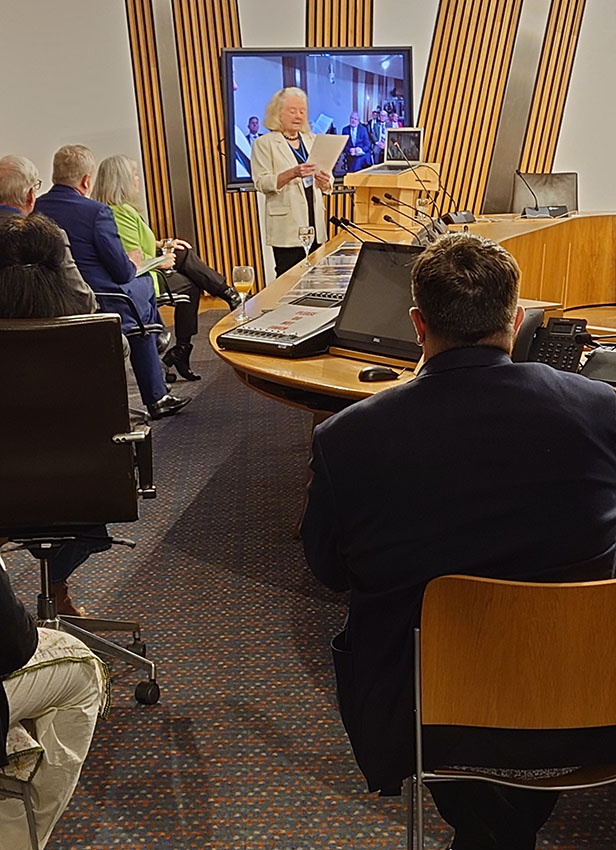
‘It is extraordinary that we now meet to remember the time, 25 years ago, when global attention was focused upon the Western Balkans, Kosovo and the conflict between Kosovan Serbs and Kosovan Albanians. The separatist tension increased to a point in 1998 when the second UN Security Council Resolution 1199 came into force. This Resolution on 23 September 1998 demanded peace within Kosovo and respect for a ceasefire.
The continuing problems resulted in both UN Peacekeeping and NATO KFOR playing key roles in Kosovo. Many of us recall the creation of KFOR as a multinational NATO-led force of 50,000 personnel. It was said, at the time, that this Force provided an ‘unprecedented level of humanitarian support’ to alleviate the sufferings of refugees, especially the Kosovar Albanian refugees.
Although the force is now 3,500 there remain serious hotspots of ethnic violence so constant monitoring is required. KFOR provides some of the bedrock for a safe and secure environment allowing freedom of movement: this is especially important for children as they travel to and from schools. Indeed, ‘normality’ can most easily be identified when we look to any post-conflict arena through the eyes of the child.
Whilst NATO-led KFOR plays this important role, the UN Peacekeeping force is in Kosovo under the UN SC Resolution 1244 of 10 June 1999. This authorised the establishment of an international civil presence in Kosovo, the UN Administration Mission (UNMIK) again at an ‘unprecedented’ level of complexity and scope. Resolution 1244 provided for authority over the territory of Kosovo, including legislative and executive powers and the administration of the judiciary.
The work of UN Peacekeeping in Kosovo has adapted and continues to adapt as the country situation changes. Whilst Peacekeeping provides legitimacy and burden sharing in navigating the difficult path from conflict to peace, post-conflict environments also require support from peacekeepers as security, stability and respect for human rights are promoted.
With so many thoughts and hopes embedded in the work of KFOR and UN Peacekeepers over the past 25 years, it is a privilege for us at UNAssociation Scotland to be part of today’s event to commemorate the anniversary of KFOR in Kosovo. We look forward to working with Heartstone when the completed Exhibition – of 100 images and interviews with the recently found personnel and civilians of the pictures – tours Scotland and beyond. Our eight UNAS branches are eagerly awaiting their turn to host the Exhibition and communicate to new generations the important work of KFOR and UN Peacekeeping in promoting peace, security and strong institutions.’
Dr Maureen Sier, Director – Interfaith Scotland,
Dr Maureen Sier followed with the presentation below, which provided the background to what had happened in Kosovo. She said:
‘Interfaith Scotland has partnered with Heartstone on several projects to date. In all these events, people have come together across all faiths, cultures and nationalities with the Heartstone photostories as the mechanism to generate meaningful dialogue. It is only through building contact, understanding and respect in this way, to see the common human story, that we can overcome conflict and hostility. For people of all faiths and backgrounds in Scotland to come together with veterans, particularly at this time, to really understand what they have done and continue to do could not be more important. For the veterans to meet people from other faiths and cultures, and particularly young people as they do through all Heartston events, is of equal importance. Heartstone achieves this in a unique and powerful way which is why we are proud to be associated with this project.
I am delighted to be here with you now to witness the beautiful and moving photographic exhibition in the making by Nick Sidle and to say a few words on the religious dimension of life in Kosovo both historically and currently. I want to state clearly that I am not an expert on religion, politics or conflict in Kosovo so forgive the limitations of this brief sharing.
Three main religions have long coexisted in Kosovo – Islam, Orthodoxy, and Catholicism. A large majority of Kosovo Albanians consider themselves, to be Muslim, there are about 60,000 Catholics and most Kosovo Serbs, consider Orthodoxy to be an important component of their national identity. Over the centuries there have also been active Jewish communities who mainly belonged to the Sephardic community. In fact, history shows that Jews and Albanians in Kosovo have also enjoyed coexisting since ancient times. Prishtina also once held the most famous Jewish bazaar in this region of the Balkans. Sadly, synagogues were destroyed as part of the communist policy to destroy the historical memory of this community in Kosovo and beyond and to be honest the Holocaust had already destroyed much of the Jewish community of Kosovo leaving only a handful of Jewish families to this day.
You will see from Nick’s photographs images of Mosques and Churches as stand-alone beautiful images or with KFOR tanks and soldiers as part of the image. The story told in these images is a sad but real one – without the tanks and soldiers, the mosques and churches would most likely have been destroyed, this is what had happened before the soldiers got there as shown in one of the images which depicts the inner destruction of a church and destruction of religious buildings was part of the conflict. It was to stop this that the tanks and soldiers were positioned as they were.
Now you may wonder why I have begun with a brief interfaith history. I wanted to do this to demonstrate that not only were there Mosques, Churches and synagogues in Kosovo but there were also ‘people’ – diverse people with diverse religious heritages that at many times throughout their history co-existed peacefully although ethnic hatred in the region goes back centuries and has been carried forwards through the generations – it is not something new – so the picture is complex – times of peaceful co-existence and times of ethnic hatred and conflict.
However, it is important to note that religion was not the cause of the recent conflict in Kosovo although ethnic-identity was. Indeed, many reports following on from the conflict suggest that inter-religious dialogue is one of the key on-going solutions to any on-going tensions.
Sadly, religion was however used as a nationalist propaganda mainly to manipulate popular emotions and channel hatred towards the Albanians and during the war, Miloesvic forces destroyed numerous Islamic facilities, including virtually all Islamic libraries and archives and after the war, Albanians replied by destroying scores of Orthodox churches. It seems that even co-existence hangs precariously from the thread of good relations and of course I believe that the critical strengthening of that thread in all nations is essential to our global peaceful co-existence. On preparing for this brief talk, I was moved to read that
‘As early as March 1999, before the NATO-led intervention, representatives appointed by the leaders of the three main religious communities in Kosovo (Islamic, Orthodox and Roman Catholic) held a joint meeting in Pristina that was convened by the World Conference on Religion and Peace (WCRP) to facilitate dialogue. The representatives expressed opposition to the misuse of religion for political reasons on all sides and called on all parties not to use religious symbols to promote violence or intolerance. They also expressed their determination to maintain direct contacts between the religious communities and to build channels of communication’
As the Director of an Interfaith organisation, reading this made me realise that there were interfaith voices for peace in Kosovo …..but sadly there were not those prepared to listen!! And what is the result of not listening to the voices of peace;
- thousands murdered
- thousands forced to flee and become refugees
- tens of thousands homeless
- Hatred, mistrust, sorrow, grief and tension continue……
An informal level of dialogue has continued on a regular basis between some members of the three main religious communities.
Another key aspect of building peace in Kosovo has been the rebuilding and protection of religious heritage sites many of which were destroyed or damaged in the conflict and its aftermath. For the same reason, rebuilding them and protecting them is a significant element in achieving reconciliation and a lasting peace. This has been a key focus of OSCE (Organisation for Security and Cooperation in Europe) who engage in mediation efforts between religious and political community leaders, supporting dialogue and offer a neutral problem-solving platform at both central and local levels.
Women are encouraged to participate in inter-religious dialogue and religious and cultural heritage protection in Kosovo. Not only does this provide valuable employment opportunities, it is also necessary for effective peace building. Women who lost loved ones during the conflict or became victims of violence themselves are an essential part of any peace process. Young people also play an important role in building confidence and tolerance among multicultural communities. In 2015 for example there was wonderful photography contest that brought together students of different communities to promote a sense of shared heritage and dismantle common stereotypes regarding “the others”.
This is exactly what this photographic exhibition will do when it is completed as well as give us a sense of what happens when hate and intolerance is not addressed. It will also demonstrate that the arts and protection of cultural heritage is a necessary element of the peace-building process after any identity-based conflict.
I want to end with acknowledging that in Scotland we began something called Scottish Interfaith Week in 2004 which grows from strength to strength every year and the idea of an interfaith week is spreading across the globe – and in Kosovo in 2013 during their interfaith week a ceremony in honour of the Holocaust victims of Kosovo took place at the site where the sole synagogue of the country’s capital Pristina once stood. This moving interfaith event was held in the presence of the Prime Minister, the President of Kosovo, the regional leaders of the Muslim, Jewish and Christian faiths, and international ambassadors.
Nick Sidle and Sitakumari have given me the opportunity through this first presentation of some of the images from the exhibition to highlight the power of co-existence, the power of cultural heritage and the power of interfaith relations to build a better more peaceful world and I wish to warmly thank them – may they continue in their global peace-building endeavours.’
Sitakumari, Director of Heartstone,
presented the background to the photostory, why and how the initial special access was secured, the importance of telling an honest story, to capture a true ‘moment of time’ and the role of photodocumentary in challenging misconceptions and stereotypes. She presented some of the images and provided a framework through which to understand the story being told visually, what elements are included in each frame and what they tell us. As such, she was able to provide an insight into the task of a documentary photographer to portray with insight what is taking shape around them without interfering and what this means in terms of observation and anticipation of events unfolding.
The Regiments featured in the photodocumentary

Most of the main regiments featured in the story were present, either live as with 45 Commando (at right), who had travelled from their base in Arbroath to be at the event, or online.
The 45 Commando personnel all had experience of being part of the KFOR mission and could therefore bring their own personal stories to the event to connect with the images.
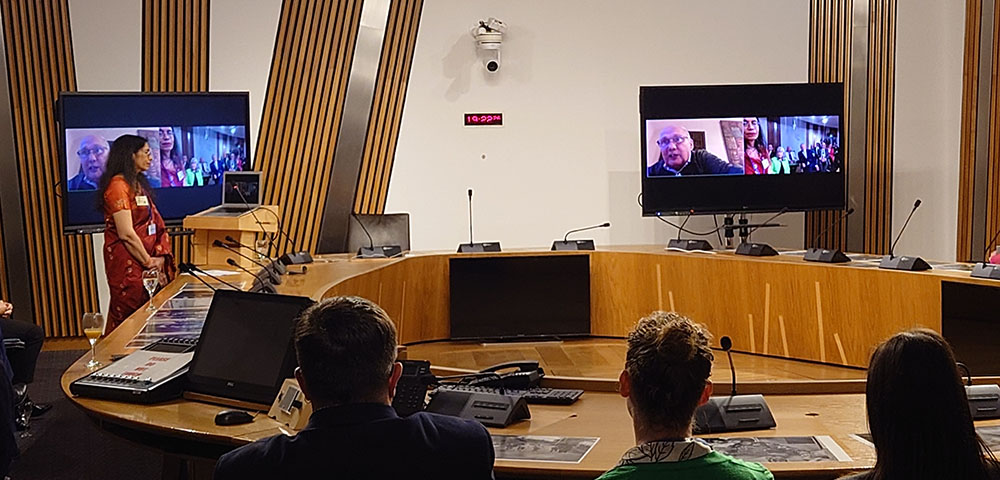
Col James Denny, Regimental Secretary for the Royal Regiment of Fusiliers based at the Tower of London, seen here at left on the screen, said:
‘The 2nd Battalion Royal Regiment of Fusiliers deployed to Kosovo in 2000 as part of the NATO peacekeeping tour. This proved to be a demanding but satisfying peace enforcement tour for the Fusiliers. Hence, as a Regiment we are very keen to support and assist with the Kosovo + 25 exhibition which highlights the importance of Peacekeeping/Enforcement operations. The Regimental link to Kosovo was re-kindled last year when our 1st Battalion deployed as part of a NATO reinforcement mission in order to reassure the divided population of Kosovo. Recent events in Kosovo in September this year have again seen the deployment of British Forces to reinforce the NATO peace mission emphasising the vital importance of peacekeeping.
Personally, for me it was a great privilege to speak about the small part we, the Fusiliers, have played in the Kosovo peace process over the last 25 years at the Scottish Parliament launch event in September and the Fusiliers greatly look forward to hosting the London launch in January 2024.’
Brig James Plastow, Chair of the Royal Green jackets Museum Trust in Winchester also joined online and highlighted the RGJ role in this project to help locate soldiers in the images and also stage the exhibition ensuring there is a nationwide presence of the exhibition in 2024. He said:
‘It was very good to be at the launch of the Kosovo+25 exhibition at the Scottish Parliament. I applaud this initiative to look again at scenes taken from that operation. We can learn from them and improve our understanding of conflict, particularly amongst the younger generation, at a time when global tensions are arguably now at their worst level since the Second World War. We look forward to hosting an exhibition in Winchester later next year.’
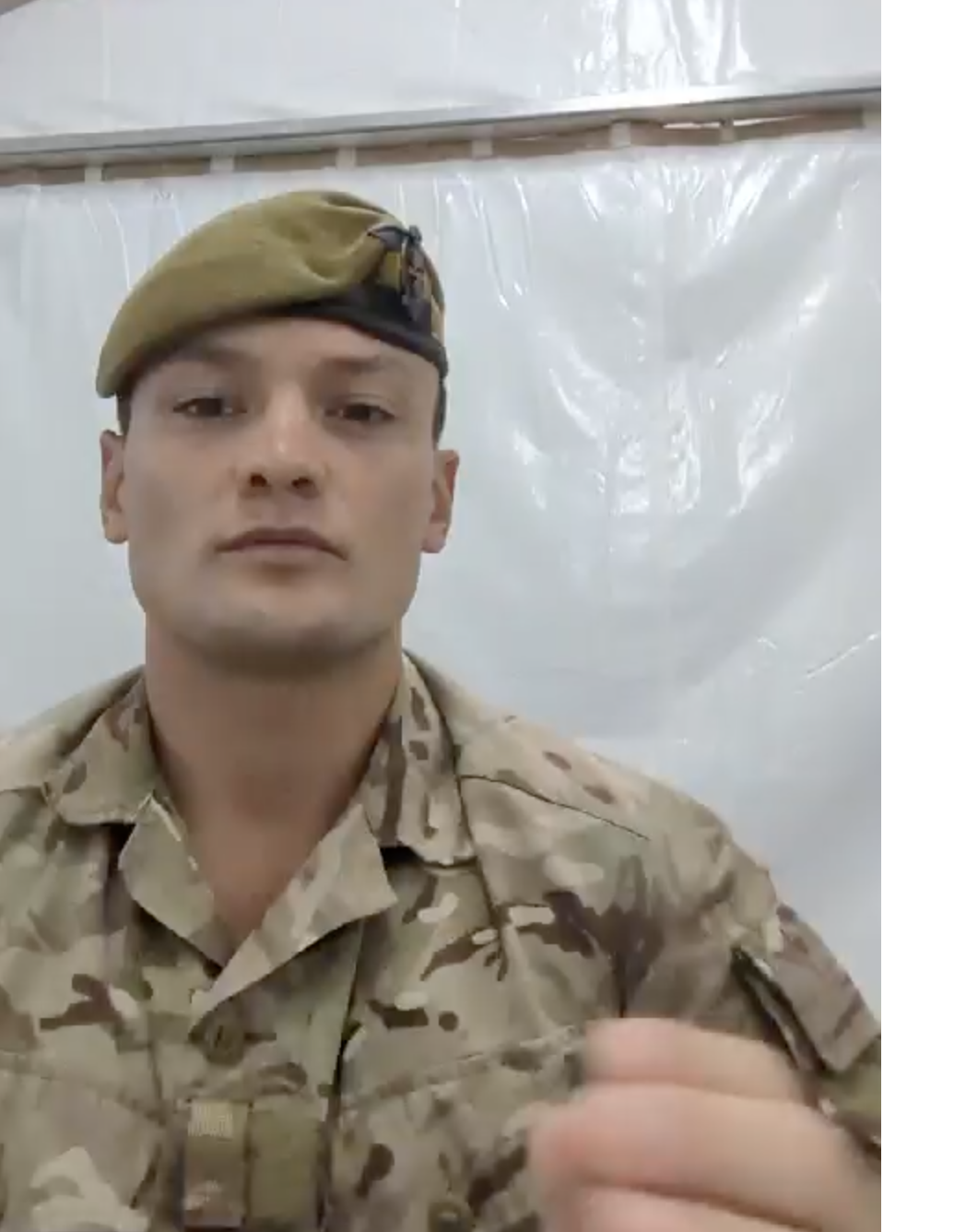
The Princess of Wales Royal Regiment joined with a recording sent through by Capt. Josh Browne (at left) on the morning of the 19th from their current deployment in KFOR in Kosovo adding a real sense of immediacy and that this remains a current story:
‘We are currently deployed in Kosovo as part of the wider KFOR peacekeeping mission to provide and maintain peace and security in the region. Firstly, my apologies for not being able to be with you in person. The work that Heartstone is doing with this project is fantastic and I would have loved to have been able to demonstrate our gratitude in person. The political situation here is still very much fragile and our presence here demonstrates the ongoing need for peacekeepers in KFOR. We are very glad and proud to be featured in the original photodocumentary and we believe it will play a vital role in reaching a wider population, helping to alert all generations to the political sensitivity in the region and the important need for stability in Kosovo and the wider Balkan states. We are incredibly excited to have our personnel featured in the interviews for the new exhibition and would like to thank Heartstone for bringing this exhibition to life.’
All the regiments participating are in the process of tracking down the soldiers in the images and helping to build the new exhibition in time for 2024.

UNAS branch representatives,
Iiris Aliska, the UNAS Parliamentary Representative, and other UNAS branch representatives were present to highlight their role as satellite installations start taking shape across Scotland. They will play a central role in assisting with stagings and presentations in each area, stimulating discussion and debate, further helping to highlight the role of UN at the time of the photostory and the continuing role today. The first installation taking shape immediately post this event is in St Andrews, Fife, and will be involving the UNAS St Andrews branch.
Photograph left to right: Dr Gari Donn, Cllr Peter Bloomfield, Ms Rhoda Grant, Mr Jack Hillmeyer, Sitakumari
One of the special guests at the event was Cllr Peter Bloomfield, 2nd from left in photograph, Armed Forces Champion for Moray Council. He had been part of the RAF bombing campaign, pre the entry of KFOR, from RAF Bruggen Germany whilst he was there as an Air Traffic Controller and had vivid memories of what had happened. This is an example of how the exhibition can include veterans with powerful stories to present, which will provide insight for today’s younger generation and for members of other communities, including those of culturally diverse and different faith backgrounds, for whom such opportunities to meet veterans is important.
 Jerry Piper, at left, Co-Director, Heartstone Confederation of International Story Circles, pictured here with guest members of the Interfaith community said:
Jerry Piper, at left, Co-Director, Heartstone Confederation of International Story Circles, pictured here with guest members of the Interfaith community said:

Nila Joshi, Director and Founder of the Edinburgh Women’s Interfaith Group (back left) and Co-Director, Heartstone Confederation of International Story Circles, pictured here with members of EWIG and friends, said:
‘EWIG members enjoyed the evening with its rich and very impressive photography, even at this earliest stage, and the enlightening presentations. Meeting with real soldiers of 45 Commando and talking about their journey was an eye opening experience and a highlight of the event.’
Photograph: Provost of Midlothian with Councillors and other representatives of Interfaith Scotland
The event was also an opportunity for representatives of other Scottish authorities to see at firsthand what is coming together and feel the genuine ‘buzz’ of excitement as this exhibition starts to take shape. Representatives present from across Scotland have now gone back to their respective authorities and in discussion on satellite installations to take shape in each location with the aim of reaching grassroots communities of all age groups and backgrounds with this story.
Guest’s comments
Shagufta Nasar:
‘The photodocumentary exhibition was a wonderful way to initiate the ‘KFOR in Kosovo +25’ exhibition. It was great to see all the stakeholders come together in a special venue to mark this very important event.
To me, all the speakers were engaging and very informative. Dr Gari Donn explained the unprecedented support offered by KFOR in Kosovo. It was interesting to hear that the presence of KFOR had changed from peace enforcement to peace keeping whilst still being crucial to the day-to-day lives of people in Kosovo. Dr Maureen Sier provided a very useful insight into the religious demographics of the region. This increased our understanding of the support required by KFOR and rebuild that was required after the destruction of key religious sites, which we could see in some of the images. Dr Sier did emphasise that the conflict was not religious however religious propaganda was used to increase conflict.
It was superb to see the global peace building efforts by Heartstone and Nick Sidle. Heartstone can use the stories from the past to highlight crucial events in history and mark them fittingly but also make them relevant for today. Sita described the photodocumentary in detail allowing us to appreciate the human story….
Ms Eliza Hoxha (MP Kosovo) provided a real and honest insight into how the conflict impacted Kosovo and herself all those years ago. She was clearly so grateful for all the support provided by international partners and KFOR in producing peace in the region. She hopes this will continue and looks forward to the exhibition coming to Kosovo to highlight the progress achieved over the 25 years. Particularly exciting, she has been able to locate a young person from the images captured all those years ago and looks forward to them locating more individuals.
To me, the event emphasised the importance of coming together to do something and not leaving it to others. This will continue the amazing work and highlight the events that have shaped history…’
Dr Claire Armstrong, Chief Executive, Royal British Legion Scotland said:
Royal British Legion Scotland (Legion Scotland) are the largest ex-service membership organisation and the custodians of Remembrance in Scotland. We understand the importance of commemorating all conflicts and ensuring that key events in our military history are marked appropriately. The importance of shedding light on modern conflicts and the impact on our serving personnel, veterans and the local communities affected by war, can never be underestimated.
Legion Scotland is proud to be working with Heartstone on the ‘KFOR + Kosovo +25’ Exhibition, a project which has really come into fruition in 2023 and through the work of Sitakumari and other supporters, an original vision to revisit the images from the conflict 25 years ago has now grown into a UK wide plan for a touring exhibition featuring the original film images from Kosovo, now restored and reworked, by the talented photographer Nick Sidle.
Acknowledgements
Our grateful thanks to the following organisations who are all partnering with us on this exhibition, project and events associated with it:
The United Nations Association – UK (UNA-UK) founded in 1945 is the country’s foremost advocate for UK action at the UN; the UK’s leading source of analysis on the UN; and a vibrant grassroots movement of 20,000 people from all walks of life. We are the only charity in the UK devoted to building support for the UN amongst policymakers, opinion-formers and the public. UNA Scotland is the Scottish branch of UNA-UK.
Interfaith Scotland is the national interfaith organisation for Scotland. We work to help ensure good relations between the diverse religion and belief communities of Scotland and also to share good practice in interfaith dialogue, education, engagement and training nationally and internationally.
The Edinburgh Women’s Interfaith Group is a safe, organic, open and informal group, welcoming women of all faiths and none. The group come together to discuss a range of topics including rituals or practices of different faith groups; peace circles; violence against women; storytelling and gracious listening; artistic project work.
Veterans organisations: PoppyScotland, Legion Scotland and Officers’ Association.
Regiments featured in the photodocumentary – Royal Regiment of Fusiliers (Tower of London), 1stQueen’s Dragoon Guards (Cardiff Castle), Princess of Wales’ Royal Regiment (Dover Castle), Royal Green Jackets (Winchester RGJ Museum). 45 Commando based in Arbroath.
We are particularly grateful for the funding received for the exhibition and events linked with it from several Heartstone sponsors, particularly Lord Michael Hintze whose support ensured development of the first images for the exhibition took place in time for this event at The Scottish Parliament.

